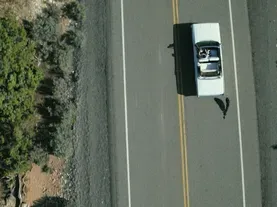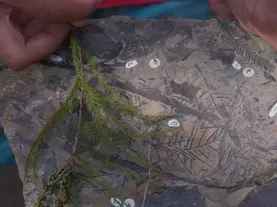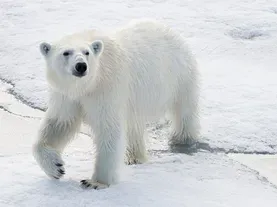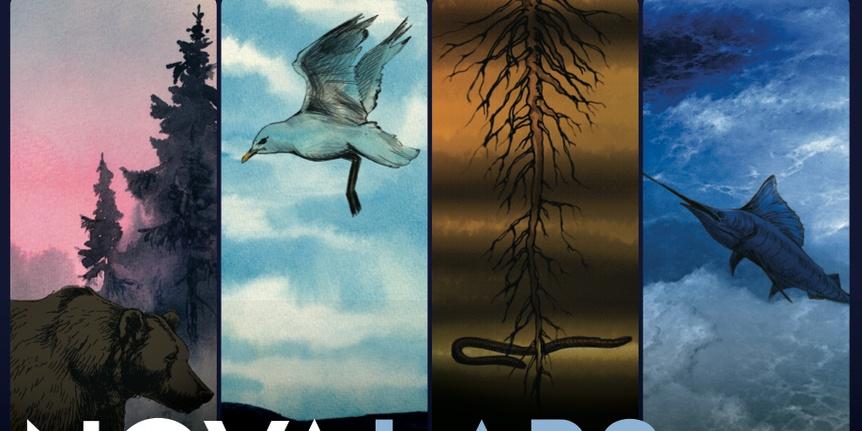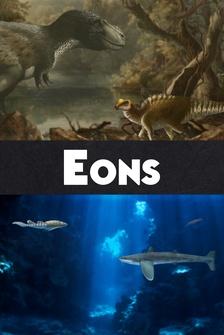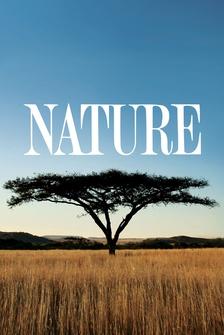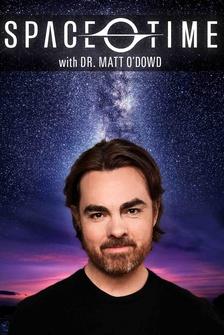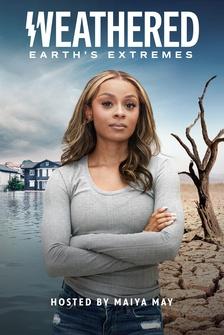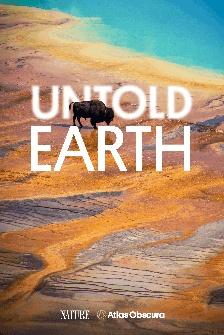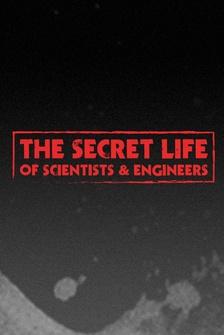KIRK JOHNSON: The Arctic... the Antarctic... our planet's ice worlds.
Vast, frozen, and empty.
♪ ♪ Yet hidden in these rocks, buried under the oceans...
PILOT: Control, boulder board.
JOHNSON: ...and trapped in the ice are clues that reveal a totally different past.
Oh my God, look at this.
Full of surprises...
It's like a whole forest.
I'm Kirk Johnson and I'm headed out on an adventure back in time... Just walking around, carrying a mammoth tusk.
...and around the globe, from one polar extreme to the other, to discover an Earth totally different...
It just looks like Mars.
...from the planet we know today.
This place, this is so totally amazing An Arctic that was once a warm, humid swamp; Antarctica full of dinosaurs; and a time when ice sheets extended from pole to pole, turning earth into a giant snowball.
What powerful forces drove the poles to such extremes?
And what does it mean for our planet's future?
(squawking) ♪ ♪ Find out the true power of ice.
This is amazing out here.
"Polar Extremes," right now, on "NOVA."
♪ ♪ ♪ ♪ JOHNSON: We're right at the mouth of the Ilulissat Icefjord.
This place is a dream.
♪ ♪ It's almost unimaginable to think that I can paddle a kayak around in a landscape of floating, frozen ice.
Think about all the other places you could be right now, then think about where you actually are.
♪ ♪ These icebergs are amazing, and they come in all sizes, from the size of little, tiny ice cubes all the way up to the size of mountains.
♪ ♪ Believe it not, we live on a planet whose fate is determined by ice.
You wouldn't think it living at mid-latitudes, but here in Greenland, it's really obvious.
♪ ♪ There is so much ice in glaciers and ice caps, mostly up here in the Arctic and down in the Antarctic.
When you add it all up, it's 70% of Earth's fresh water.
I'm paddling towards two of the most spectacular icebergs I've ever seen in my life.
This stuff looks so solid, so vast, so permanent.
But looking around at these giant floating mountains, you've got to wonder, "How did all this ice get here?
How long did it take to form?"
And, of course, "How long will it last?"
For the whole time that humans have been on this planet-- around 300,000 years-- there's always been ice at the poles.
But if you look at the entire history of Earth, Homo sapiens' existence has happened in just the blink of an eye.
If we could travel back in time-- hundreds of millions of years-- what would the Arctic and Antarctic look like?
Ice at the polar extremes is vital to the health of our planet.
If it disappears, what can the past tell us about the future?
How close are we to a tipping point?
♪ ♪ (voiceover): That took me by surprise.
To answer these questions, I'm joining scientists working around the world... Oh, yeah!
Digging... Oh!
There's a perfect three-million-year-old clam!
This is like a window to the past.
JOHNSON: Drilling... JIM WHITE: You can actually see the annual layers, even at this level.
JOHNSON: And probing... DAVID HOLLAND: First we're going to lower the probe.
Probe deployed.
JOHNSON: To unlock the hidden history...
Okay, so it's cold.
JOHNSON: You're better than me, I'll tell you.
...of the polar extremes.
♪ ♪ Oh, yes!
I'm a paleontologist.
Get-get this edge right here.
Yes, sir.
JOHNSON: I love finding fossils of all kinds, but I have a special place in my heart for fossil plants.
(laughing) MAN: Oh, my God.
JOHNSON: Like this palm frond I found in Alaska a few years ago.
Whoa.
(plane engine droning) My first stop on this journey is one of the most remote places on Earth, with some surprising secrets locked in its rocks.
I'm on my way to Ellesmere Island, high in the Canadian Arctic, next door to Greenland, and it's only 800 miles from the North Pole.
We just crossed over latitude 77, and we just left Grise Fiord, which is the northernmost town in North America, and we're going north.
♪ ♪ There's just clouds and ice and rock.
It just looks like Mars, it's a magical place.
This far north, there are no roads, no airports, and definitely no runways.
He's coming in right now.
Landing on uncharted ground is a nail-biting experience.
Hold tight, hold tight.
Even for a seasoned Arctic guide like Jason Hillier.
(plane droning) There we go.
That's what we call an... That's an Arctic landing right there.
He hit the brakes pretty hard.
Whoo!
That was awesome.
HILLIER: Terra firma.
JOHNSON: Ellesmere!
JOHNSON: You got to have a really good reason to want to land a plane here.
It's a great place to be; I mean, this is a most beautiful spot.
(engine droning) There's always the moment when that Twin Otter leaves, and you're standing here realizing that there's nobody for hundreds of miles around.
You're all alone out in the amazing, wide world.
Time to get down to business.
I know.
JOHNSON: I've come here to try and figure out what life was like in the Arctic millions of years ago.
There's a two-month-long window in summer when conditions are right for fossil-hunting.
This is also a trip back in time for me.
I first came here in 1984, when I was only 23 years old.
My first trip to Ellesmere Island changed the way I looked at planet Earth.
It sealed my fate.
After that trip, I knew I had to become a paleontologist.
Yeah, these are good memories.
It's great to be back here.
In addition to Jason, Dave Briggs is here to protect us from any stray polar bears.
Okay.
JOHNSON: And completing the team is fellow paleontologist Jaelyn Eberle.
♪ ♪ Once camp is set up, Jason is going to help me find a special site that I never got to see the last time I was here.
It's just straight northwest for four kilometers.
Right.
Just a little bit of a hike.
Then we, uh, sort of head northwest, I guess.
♪ ♪ JOHNSON: The beds are dipping pretty steeply here.
HILLIER: Yeah, it's definitely something we have to be careful of with this mud.
♪ ♪ There's a bit of a precipice over there, although it's generally in the direction of where we're going.
♪ ♪ JOHNSON: Our target is several hours' hike from our camp.
♪ ♪ This frozen tundra may look barren, but for me as a paleobotanist, this is geologic heaven.
There are a few small Arctic wildflowers and some scrappy ground cover.
But the nearest living tree is a thousand miles south of here.
HILLIER: You know, the coordinates are, they're, our best guess are somewhere in this vicinity.
JOHNSON: Finally, we reach what I've been looking for.
Wow!
Oh, my God, there's some amazing stumps here.
Look at this.
Sticking out of the hillside are a bunch of weird brown rocks.
These are petrified tree stumps.
HILLIER: Wow.
One, two, three, four, five, six, seven, eight, nine, ten, 11, 12, 13, 14, 15, 16, 17, 18.
In one view, 18 trunks in place.
Ah, this is incredible, man.
This is, this is amazing.
It's like a whole forest.
Look at that one, that one is just perfect.
You can see the whole shape of the trunk.
It's quite an amazing thing-- just insane.
This is a stone tree trunk, it's a petrified tree.
It used to be a growing tree, then it got buried and turned into stone.
Geologists have dated these trees to around 50 million years ago.
Back then, this treeless hillside would have been completely different.
There's a lot of clues here to how this forest got to be the way it is.
The first is that all these stone trunks are surrounded by coal-- black rock, which is a very strong signal that these trees, when they were growing, were growing in a swamp.
The second clue are these radiating roots.
In swamps, roots grow out and not down.
♪ ♪ But what kind of trees were these?
These rocks are just chunky silt stones that are quite near the petrified forest, and I'm breaking them apart because I'm looking for fossil leaves.
If I can find the leaves that go with those trees, I can put that forest back together again.
Come to papa.
Ah, now, here we go.
Here's a close-up of that thing.
What have you got?
This is metasequoia, little needles.
It's the dawn redwood, it's a conifer, and these whole sprigs will fall off, as they've done here, and land in the mud.
This used to be mud, now it's a rock.
It would go with those trunks, the petrified forest.
(blows dust off rock) Together, these leaves and the tree trunks give us a window into the past.
50 million years ago, this dry, barren tundra was a warm, humid swamp... (insects chirping) covered with lotus plants, ferns, and metasequoia trees that were as tall as 150 feet.
♪ ♪ The area covered in ice today was once a massive forest that stretched all the way up to the edge of the Arctic Ocean.
Water ran off the land, forming a surface layer of fresh water.
Instead of sea ice, the North Pole was covered in subtropical floating ferns.
♪ ♪ The Ellesmere we see today looks very different, but one peculiarity of the Arctic summer remains the same.
One of the things about working in the Arctic is that the sun literally never goes down.
It just goes around and around in the sky.
That means there's never any night, and it never gets dark.
It's midnight right now-- take a look outside my tent.
Yep, it looks pretty bright out there.
But-but I want to go to sleep, so I'm going to go to sleep.
Here's how we do it.
Close the tent.
(pulling zipper) Zip up the sleeping bag and put on the face mask.
Good night.
In the morning, I head out to join Jaelyn Eberle.
While I've been out looking for fossil plants, she's been hunting for the animals that lived in this warm polar swamp 50 million years ago.
Maybe through here?
And then up and over and then back down the other side.
EBERLE: I think so, yeah.
I'll put my boots on then.
Do you have boots?
I've got sandals.
All right, you're better than me, I'll tell you.
(both chuckle) We're going.
Okay, so it's cold.
I wouldn't want it to be any deeper.
There we go.
JOHNSON: You beauty.
EBERLE: All right.
JOHNSON: Jaelyn's spent many summers up here searching for fossils.
EBERLE: I do love the Arctic.
I've been coming up for... oh wow, I think ten field seasons now.
And almost everything you pick up is undiscovered, that's something that doesn't, to me, ever get old.
That's exciting.
JOHNSON: Searching for animal fossils in the permafrost is really tough.
They're little bits and pieces, so they're not going to show up a lot.
I think we're going to need to crawl.
JOHNSON: The annual freezing and thawing break up the bones into tiny fragments.
Eh.
Eh, probably not, but, um, could be a little piece of bone.
Tooth of anything right now actually would be great, 'cause they're pretty rare.
Even the bits and pieces are pretty rare at this site.
JOHNSON: After around four hours of crawling about-- today, nada.
But over the years, Jaelyn's team has unearthed a fantastic collection of creatures.
EBERLE: These guys are pretty impressive.
Looks like two jawbones missing their teeth Yes, that's right.
So it's a... And those come from a mammal called Coryphodon, and there are no Coryphodons living today.
An analogy you could use today would be something like a pygmy hippo.
And living in the rivers and stuff like that?
Yeah, probably, living in the rivers and the swamps and munching on aquatic plants and...
Right.
JOHNSON: Coryphodon was a hippo-like mammal with short tusks and a tiny brain that weighed just three ounces.
Standing around three feet high and eight feet long, Coryphodon was a vegetarian that rooted around the swamp for its food.
Paleontologists have found fossils of all sorts of animals here.
With warm temperatures all year round back then, there were turtles, tapir, and even alligators.
♪ ♪ The fossils we find here on Ellesmere Island tell a remarkable story.
The Arctic was warm and wet, with no ice in sight.
It was filled with plants and animals similar to ones you might see today in the swamps of Louisiana or the Amazon.
The frozen north was a completely different world 50 million years ago.
♪ ♪ And that's got to make you wonder, "If it was like this at the North Pole, what was happening at the other end of the earth?"
10,000 miles south of Ellesmere is the world's wildest continent, the most extreme place on the planet.
There's one word that describes Antarctica, and that word is ice.
And the entire continent is one ice-bound mass.
♪ ♪ In fact, 90% of the ice on planet Earth is here in Antarctica.
With a record low temperature of minus-128 degrees Fahrenheit, this continent is officially the coldest place on Earth.
Even in summer, the temperatures rarely ever get above freezing.
Antarctica is the size of all the United States plus Mexico, and it's covered with a sheet of ice that in some places is almost three miles thick.
That's a lot of ice.
♪ ♪ But has Antarctica always been deep-frozen like this?
To investigate, I've come to Nelson Island, off the Antarctic peninsula.
I'm joining paleontologist Marcelo Leppe from the Chilean Antarctic Institute.
Marcelo's taking me to a small island... one of the few spots with exposed land, where he and his team have been hunting for fossils.
LEPPE: After a week, we didn't find a, a fossil.
Wow, you looked for a whole week and you found nothing?
Yeah.
We started to make a hole in the ground, just close to the, to the sea, and we found the-the outcrop.
Just by accident.
Do you think we can find it today?
Uh, I-I hope so.
(both chuckling) ♪ ♪ JOHNSON: The outcrop we're after is only accessible at low tide, so we've had to time our landing just right.
Let's drop our gear here, huh.
It's cold.
Yeah, it's Antarctica.
It should be.
(both chuckle) ♪ ♪ Just like on Ellesmere Island, the bedrock on this beach is tens of millions of years old.
(shoveling continues) ♪ ♪ Ah.
Not a great one, but it's definitely a fossil.
We're in the right spot.
Crawling around on this rocky landscape today, it's hard to believe that anything could ever grow here.
Antarctica has no trees at all.
(voiceover): Just mosses and lichens and only two species of flowering plants.
So you find a fossil plant here, it's telling you about a very different world indeed.
But after just ten minutes of digging... Ooh.
(voiceover): We find something incredible.
Ah, wow!
Just like that.
(voiceover): A beautifully preserved leaf from an ancient beech tree.
That one looks like a modern beech.
It's the size of a beech leaf, wow.
And it's large.
You can see that it's the middle section.
There's the main vein, the lateral veins.
Leaf would have been about that long and about that wide.
And these very straight secondary veins are typical of the beech family, a northern, temperate-forest tree, a tree that's deciduous, you see it growing in New York City and in London.
And here is a chunk of it from the beach in Antarctica, next to an iceberg, on a very cold day.
Oh, look at that one.
That's great.
We're finding forest tree leaves, and they're found in great numbers, all together like leaf litter, implying the forest was right here, where we are standing-- or kneeling, right now.
(digging and brushing continue) (voiceover): These fossil leaves reveal a very different picture of Nelson Island from the landscape we see today.
83 million years ago, this frigid place was covered in a verdant forest of southern beech, ginkgoes, and tree ferns, with mild temperatures rarely dropping below freezing.
♪ ♪ And it wasn't just this one spot.
I've just been on the beach, found these amazing fossil leaves.
These leaves, on the other hand, are from a different place, they're from southern Chile.
We're here, here's a 700-mile gap, and here is southern Chile.
This leaf here is from southern South America and is very characteristic of the beech family.
As is this leaf from Antarctica, that we just collected this morning.
So we have Chile and Antarctica, pretty strong evidence that these two places were connected.
We've known for a while that Earth's crust is broken into plates that slide and collide on top of hot, flowing rocks deep beneath the surface.
Evidence like matching fossils from South America, Antarctica, and even Australia tells us that these three continents were once joined together and covered with a vast forest stretching across the South Pole.
♪ ♪ So, with all these trees and a nice, warm climate, what kinds of creatures lived on this ancient southern continent?
Although fossils have been found in Antarctica, some of the biggest clues are in Patagonia.
♪ ♪ At a remote site in Argentina, a team of paleontologists has just discovered the remains of a forest dweller.
DIEGO POL: Here we are.
JOHNSON: It must have had a very large appetite.
This guy was, you know, all scattered around, all the bones.
JOHNSON: The leader of the expedition is Diego Pol.
POL: We found the entire forelimb.
Okay, that's great.
And the other hind limb and then some vertebrae and the tail and so on.
JOHNSON: All these parts add up to a 69-million-year-old dinosaur.
MAN: Let's go.
JOHNSON: I'm just going to start chipping away at this thing.
POL: Yeah.
JOHNSON: The key thing to not destroying a dinosaur fossil is do not let a paleobotanist in the dinosaur quarry.
'Cause we tend to break big rocks with pickaxes and sledge hammers, and these guys use little, tiny picks and brushes.
We're not trying to expose the bone, we're just trying to undercut it gently and get the rock removed.
So, I'll just carefully pick around here at the base.
(picks clanking) See how delicate I am?
You know, I'm doing a beautiful job of carefully extracting this bone from its rocky tomb, where it's lain undisturbed for 69 million years.
(voiceover): I need to watch my hammer with this specimen, because it's pretty unique.
This is a dinosaur without a name.
It's a new species of dinosaur, and that's a really cool thing.
(voiceover): Diego's team has just discovered a new species of titanosaur... (pick scraping) ...a plant-eating dinosaur with a long tail, long neck, and small head.
Titanosaurs could become so big because there was so much vegetation.
And some species grew to be the biggest animals that ever walked on land.
♪ ♪ POL: Some people estimate these animals were eating, like, a thousand pounds plant material per day.
A thousand pounds a day?
A thousand pounds a day.
Like half a ton of vegetables a day.
The original vegans, right?
Oh, my God.
POL: Yeah, these animals probably had a pretty big home range.
They'd go and destroy one forest for a while At a time... Then go destroy another forest.
POL: And then come back.
JOHNSON: With South America and Antarctica connected into one continuous continent, these munching monsters had plenty of forest to roam in search of a good meal.
Did they have any titanosaurs from Antarctica?
Yeah, actually, there is one.
I mean, they found a single bone.
It was found in Antarctic peninsula.
One bone?
A single bone.
A tail bone.
Wow.
What a lucky find that was.
Yeah.
That's amazing.
So, we're really looking at an animal that could have walked easily to Antarctica.
Absolutely, this... For a good sandwich.
Yeah.
(picks clinking) JOHNSON: This fossil is a fantastic find.
But in 2014, not far from here, Diego and his team uncovered a creature even more awesome.
♪ ♪ This is the femur we collected yesterday.
It's big, but it's nothing compared the biggest dinosaurs.
This one is the largest one ever found.
All right.
Check out the size of those vertebrae.
Each single backbone is about four feet tall.
I'm a big guy... but this bone dwarfs me.
(voiceover): I'm lying next to the eight-foot-long titanosaur thigh bone that Diego's team unearthed.
♪ ♪ And just in case you can't picture how big this was...
This thing is absolutely immense.
(voiceover): There's a life-size model of this 75-ton beast that greets you when you drive in from the local airport.
I've seen the bones, but I haven't seen the reconstruction before.
♪ ♪ Patagotitan, the world's largest dinosaur.
It's incredible to realize that animals like this once roamed between South America and Antarctica.
So what's going on here?
Dinosaurs near the South Pole... (dinosaur bellows) and swampy forests in the North-- were the poles really that warm back then?
Or could there be another explanation?
What about those tectonic plates that move the continents around?
Could this be the reason that we find these warm-weather fossils in the polar regions today?
Sometimes people tell me that, "Well, wait, "plate tectonics mean that landmasses can move around, "and maybe those fossils you're finding "were deposited at mid-latitudes then brought to the Arctic by continental drift."
It's a good thing to think about, but we actually know where the continents were when they were there.
We actually know those positions.
And we know for sure that Antarctica was down by the South Pole and the lands at Ellesmere Island were up by the North Pole when they were forested by these warm forests.
So, it's a good idea, but the science says, "Nope, there really were polar warm forests."
♪ ♪ The entire planet really was warmer, and all the polar ice we see today didn't exist tens of millions of years ago.
That is pretty weird.
But there's an even weirder part of the story of ice on this planet.
This time, the evidence isn't at the poles.
♪ ♪ It's in the hottest place on Earth.
♪ ♪ Welcome to Death Valley.
I'm here at the National Park's official weather station at the appropriately named Furnace Creek.
Ranger Alex Rothermel is letting me take today's measurements.
So this is our rain gauge.
It hasn't rained in a while.
Ow, it's always... Is it hot?
Yeah, it's metal.
Hold this?
Okay, yeah.
We'll see if there's any water in it.
Ooh, that is certainly hot.
Yeah, it's metal.
All right, there's nothing in it.
Dust!
(both laughing) This is the temperature gauge.
I see, so it's in the shade.
Let's see on this...
I'm reading like 103 and a half, is that what you get?
Yeah.
And you check this every day?
Yeah, we do, and then we record it.
July to August, it's been something like 28 days over 120 this year.
Wow.
So you've got a pretty legitimate claim to be one of the hottest places on the planet.
Yeah.
Oh, we are the hottest place on the planet.
All right, so, you actually hold the all-time record here?
Yes.
And you love this place?
Yeah.
This is the best national park.
It's the best place on Earth, I love it here.
And the hottest place on Earth.
Yes.
♪ ♪ JOHNSON: But has it always been that way?
Geologist Francis Macdonald has spent many years battling the heat in these desert hills, searching for clues that might reveal the secrets of Death Valley's past.
MACDONALD: Why I really like coming out here is that all of this raw rock.
Here in Death Valley, you're not limited by rock, you're limited by how far you can walk out there in this hot weather.
JOHNSON: The rocks here date back to a time way before the dinosaurs, long before trees or even plants existed.
MACDONALD: Why, in this rock formed 640 million years ago, do we have these rocks within the rock?
This one's a granite.
Okay.
And it's surrounded by this pink sand and silt and mud.
And here's another quartzite piece.
Here's a-a piece of carbonate.
They're different rock types, they're telling you about where they originally formed.
JOHNSON: These rocks came from a whole bunch of different places?
All over the place.
JOHNSON: What could have brought this strange mixture of rocks here and encased them in silt?
MACDONALD: We need a process that's just going pick up rocks from all over and dump-truck them into a pile of mud and sand.
And we do know one process that does that, and that's glaciers.
So, we're sitting here in Death Valley, and it's about 95 degrees, and you're pointing to a rock and saying that it was deposited by a giant slab of glacial ice?
So work with me here a little bit.
Okay.
You've got to use your, use your imagination.
♪ ♪ JOHNSON: What these rocks tell us is that 640 million years ago, the climate here in Death Valley must have been much colder.
So cold that what's now a scorching desert was covered in giant sheets of ice as big as you'd find in the polar regions today.
The idea of an ice-covered Death Valley is strange enough.
But these rocks tell us something even more astonishing about how far the ice extended.
Even though here we're sitting today at, say, about 35 degrees north of the equator, we know 640 million years ago this was far further south, and it was situated very close to the equator.
♪ ♪ JOHNSON: Earth's tectonic plates have shifted quite a bit over the last 640 million years.
Back then, Death Valley was part of a huge landmass that sat right on the equator.
So, if the ice made it to here, it likely stretched all the way from both north and south until it met in the middle, making the entire planet a snowball Earth.
♪ ♪ For me, this is a pretty mind-blowing realization.
Wherever you are in the world, by uncovering evidence in the rocks and fossils, you can travel back in time and reveal that Earth's climate has undergone incredible changes.
♪ ♪ You have to split a huge amount of rocks to find a fossil.
♪ ♪ The only way to find them is just to work your way down through the layers.
♪ ♪ So, just sort of chop a staircase down the hill.
Sometimes an entire hill.
(pick clinking) In fact, we can use the chemistry of rocks and fossils to find the temperature at the time those rocks formed.
Piecing together data from sites across the globe, scientists can build a temperature timeline going all the way back to 500 million years ago.
Laying out Earth's temperature like this, you can see a pattern.
The climate fluctuates between long periods when it's warm, with no ice at all-- hothouse worlds-- and cooler episodes with ice caps at at least one of the poles-- icehouse worlds.
The hot climates are three times as common as cold climates.
And yet, perhaps surprisingly, we live in one of the icehouse worlds today.
♪ ♪ Today, we live on a planet that has ice at both poles.
We think that's normal, 'cause that's our world.
But when we look at the fossil record, we realize that our planet has only had four episodes where there's been glacial ice.
Only about 25% of the last 500 million years has our planet been like it is today.
♪ ♪ So, why is this?
Why has Earth spent so much of its past as a hothouse-- much warmer than it is now?
We can find clues from a close neighbor in our solar system.
I'm looking at Venus.
It's the third-brightest thing in the sky after the sun and the moon.
It's also one of our nearest planets.
But Venus has a very unusual feature-- it's about 800 degrees Fahrenheit on the surface of Venus; it's hot enough to melt lead.
♪ ♪ (voiceover): Why is Venus so hot?
It is a little bit closer to the sun than we are, but not enough to explain the huge temperature difference.
♪ ♪ We found the answer back in 1967, when the Soviets sent the Venera 4 space probe to Venus.
Just before it was crushed by the huge atmospheric pressure, the spacecraft beamed back its precious data.
It had identified one critical component of the planet's atmosphere.
The reason Venus is so hot is that its atmosphere is composed almost entirely of carbon dioxide, 95%.
♪ ♪ This thick atmosphere, rich in CO2, acts like an insulating blanket.
Most energy from the sun passes through this layer, but when it radiates back from the planet's surface, the carbon dioxide traps the heat.
This is the greenhouse effect, which drove Venus to get hotter and hotter.
♪ ♪ It didn't just heat up-- it boiled.
Venus is a clear example of a runaway greenhouse climate, what happens when you get too much carbon dioxide in your atmosphere.
(voiceover): So if carbon dioxide can warm up a planet, is this what created all those hothouse worlds in Earth's past?
(insects chirping) How can we know how much CO2 was in the atmosphere millions of years ago?
(gate creaks) ♪ ♪ The answer may be hiding in some very special leaves.
And deep in a forest just outside Washington, D.C., is an experiment to try and unlock their secrets.
The experiment is being run by one of my former students, Rich Barclay.
Hey, Rich.
Oh, hey, Kirk.
How's it going, man?
Good to see you.
Hey, welcome to the Fossil Atmospheres Experiment.
JOHNSON: He's investigating the ginkgo tree.
The ginkgo is pretty special, because fossils tell us that this species has survived almost unchanged for the last 200 million years.
Since all plants use carbon dioxide to grow, a plant that's been around that long might be able to tell us how CO2 levels have changed.
Rich is growing them in custom-made atmospheres to see how different amounts of carbon dioxide affect the leaves.
So each of the chambers in here has a-a different CO2 concentration.
This is a control tree, at 400 parts per million.
600, the next treatment up.
800 parts per million.
The final tree at 1,000 parts per million.
Can we go in there?
We can go into the, into the chamber, yeah.
This tree is growing at 1,000 parts per million.
We put a tag around the branch, so you can just wrap that around the branch.
JOHNSON: And so I take the leaf that's right above that one?
Yep, that one right there is fine.
So, what we do with the leaf is we take it back to the lab, and we can look at the-the details of the leaves under a microscope.
JOHNSON: The leaves all look pretty much the same to me.
But put them under a microscope, and you see something really cool.
This is the surface of a ginkgo leaf from this experiment.
You have to go in about 200 times magnification.
JOHNSON: Now, you can see that the leaf from today's atmosphere is perforated with tiny holes called stomata.
This is where the plants take in the carbon dioxide they need for photosynthesis And what Rich is discovering is that adding extra CO2 does something striking to the stomata.
Then I've got this one.
And it's really obvious to me that there's far fewer pores on this one.
BARCLAY: That one's from the 1,000-ppm chambers.
As CO2 increases, they don't need as many stomata, they can become more efficient.
JOHNSON: More CO2, less stomata.
BARCLAY: More CO2, fewer stomata.
JOHNSON: This happens with all kinds of plants that take in carbon dioxide.
But because ginkgoes have been around for 200 million years, they can preserve a snapshot of Earth's CO2 levels in the deep past.
This is a fossil of ginkgo.
It sure is, it's like, it really looks like ginkgo, I mean, this leaf and that leaf are almost identical.
How old is this one?
This fossil is 56 million years old.
And then when you take that, you can put it under a microscope and see the exact same features as you find on the modern.
JOHNSON: Right there on the fossil is the pattern of stomata: many fewer than on the leaves today.
Fossils from all around the world help us estimate CO2 levels going back more than 400 million years.
If we look back on our temperature timeline, we see that when CO2 levels are high, it's hot.
And when CO2 levels drop, it cools.
When this ginkgo was alive 56 million years ago-- about the same time that swampy forests were growing on Ellesmere Island in the Arctic-- the amount of CO2 in the air was roughly four times what it is today.
So, where did all that CO2 come from?
♪ ♪ One possibility is from deep inside the Earth.
Here at Mammoth Lakes in California, the ground is belching out steam and gas, and the pools are literally boiling beneath our feet.
Because right under these mountains is one of the largest super-volcanoes in America.
Wow, this place is pretty cool.
Yeah, it's amazing, isn't it?
JOHNSON: Geologist Kayla Iacovino studies volcanoes all over the world.
We don't want to get too close to the edge of the water here.
The ground is quite unstable.
If you did fall through, that would be very, very bad news, so...
Okay, I won't do that.
Do you want hold on to this, carry it off... Yeah, I hold this, right?
All right, here we go.
JOHNSON: Kayla's taking measurements to monitor the volcano's activity, starting with temperature.
It's like trout fishing.
You sneak out to the edge of a creek, you lower the line over the edge... And you wait, yeah.
...you're waiting.
JOHNSON: Next, she needs to measure the composition of the gas rising out of the ground.
So you want to use this little tiny mud pot?
Yeah, this looks like a good one.
This is a CO2 meter.
Okay.
and it can tell us the concentration of carbon dioxide in the gases that we measure.
JOHNSON: The level of carbon dioxide in the air is around 410 parts per million.
But the reading from the mud pot is much higher.
There we go, 3,000 parts per million of CO2 Wow.
The magma that sits deep within the Earth contains lots of carbon.
When this magma gets close to the surface-- at a volcano-- that carbon is released into the air as carbon dioxide.
Kayla is part of a team of scientists measuring how much CO2 is being released from volcanoes all over the world.
This is basically volcano by volcano by volcano?
That's how it's done, they actually look at individual volcanoes?
Yep, and they kind of add them up together.
JOHNSON: Even volcanoes encased in ice, like Mount Erebus in Antarctica, are spewing out carbon dioxide.
Mount Etna in Italy is built on carbon-rich rocks and belches out more CO2 than almost any other volcano.
When geologists estimate all the CO2 coming out of volcanoes today, the total is around 300 million tons a year.
That might sound like a lot, but it's not enough to significantly change global temperature.
The amount of CO2 coming out of volcanoes today just doesn't even come close.
Huh.
It's tiny compared to the amount of CO2 that humans are putting out, for example.
What it takes to actually warm the planet from a volcano, from volcanic CO2, is a massive amount of CO2 put out over a very long period of time.
♪ ♪ JOHNSON: Today, Earth's volcanoes are relatively quiet and aren't cooking up a whole lot of CO2.
But in the past, it's been a very different story.
♪ ♪ This ten-mile-wide basin looks peaceful today.
But many thousands of years ago, it was the site of a huge eruption that spewed out 150 cubic miles of lava and ash.
And this is just one spot.
We know that at certain points throughout Earth's long history, volcanoes and other geologic activity released much more CO2 into the atmosphere than today.
And sometimes this continued for millions and millions of years.
That's what geologists think must have kept the planet so warm during all those long periods when Earth was a hothouse, giving us warm polar forests teeming with life.
♪ ♪ But if volcanic activity keeps releasing carbon dioxide, why hasn't CO2 built up in our atmosphere, making our planet overheat like Venus?
♪ ♪ Earth must have something Venus doesn't-- a way of taking carbon dioxide out of the atmosphere and putting it somewhere else.
It turns out here in the mountains of Alaska, I'm experiencing it.
What's falling on my hands and my face right now is rain in the mountains, and it's got dissolved CO2 in it.
Rain absorbs CO2 from the air, and then the raindrops combine to form streams that eventually become fast-flowing rivers.
The dissolved CO2 makes the water slightly acidic, helping it erode and weather rocks, releasing elements like calcium, magnesium, and silicon.
♪ ♪ Riding these rapids gives me a sense of just how powerful this river is.
Yeah!
Whoa!
Off the edge, yes!
It's like a saw that's cutting right down, the canyons are just cutting their way into the mountain range and just chopping them in half.
(voiceover): The water I'm rafting on now is full of just the right chemical elements that will help lock up carbon.
♪ ♪ (laughing) That was awesome.
Eventually, all the water in this river will end up in the Pacific Ocean, and with it, all of those dissolved minerals.
Once they reach the ocean, the dissolved elements are taken in by tiny sea creatures and used to build their shells.
Over millions of years, these shells drop down to the sea floor, forming layers of limestone, locking the carbon that used to be in the atmosphere into rocks.
It's the final stage of a process that's been driving our climate for millions of years-- the carbon cycle.
There's a finite amount of carbon on planet Earth.
When that carbon is in the ground, locked up in rocks or sediments, then the planet is cool.
And when that carbon is up in the atmosphere as carbon dioxide, the planet warms.
And the climate history of our planet is this tug and pull between carbon in the ground and carbon in the atmosphere.
♪ ♪ We can see how this balance plays out on the planet's southernmost active volcano, Mount Erebus.
Here in Antarctica, this mountain terrain is encased in ice year-round.
There is no rain, and there are no rivers.
The weathering part of the carbon cycle is stalled.
Meanwhile, the volcano continues to spew out CO2.
♪ ♪ Mount Erebus is a window into what it was like 640 million years ago during snowball Earth, when the planet was covered in ice.
With CO2 from ice-covered volcanoes building up, the planet eventually got warm enough to melt the snowball.
If adding CO2 is how we melt a frozen planet, then how do we freeze a warm one?
♪ ♪ About 50 million years ago, after more than 200 million years in a hothouse, carbon dioxide levels started to drop, and the Earth began to cool.
Eventually, gigantic ice sheets began to form, first in the Antarctic, and then the Arctic.
A new era had begun that we still live in today-- the icehouse.
But where did all this ice come from?
How do you build an ice sheet a mile or two thick when you start with nothing?
To take a closer look at how ice sheets form, I'm going to climb down into a glacier.
Do that.
With a little help from mountaineer Brian Rougeux.
Perfect.
Wish me luck.
Have fun down there.
JOHNSON: There's actually an overhang.
Yeah, get your butt as low as you feel comfortable and then take a step down.
JOHNSON: First, I have to hop over this year's snow layer.
It's quite a step.
Nice.
(Johnson laughs) It's like a foot-and-a-half overlap, man.
Nice work.
JOHNSON: Beneath the overhang are snow layers from previous years.
Pretty amazing to be hanging out here in this ice world and to imagine how this ice even got here in the first place.
(voiceover): Each year, it snows in the winter.
In most places, snow melts in summer.
But here, the summers are so cold, the ice never fully melts, and next year's snowfall piles up on top.
Snows falls in the winter, and it stays there throughout the summer, and the next summer, and the next summer, and the next summer.
(voiceover): Over many winters, the snow pile gets higher and heavier, compressing the snow.
(snow pack crunches down) The weight of the snow pushes down and compacts the underlying layers into ice.
♪ ♪ (voiceover): Over thousands of years, these layers build up until they form an ice sheet, and that's exactly what happened at our poles.
When carbon dioxide levels fell, around 50 million years ago, the temperature started to drop, and ice eventually took hold at the bottom of the planet.
Our icehouse world started 34 million years ago, here in Antarctica.
♪ ♪ But carbon dioxide wasn't the only culprit responsible for the deep freeze.
It turns out there was something special about Antarctica-- its position on the globe.
In that direction, 700 miles, is the southern tip of South America.
In between me and South America is what's called Drake Passage.
This stretch of water is one of the most feared passages in the world.
It's got tremendous storms.
♪ ♪ I feel really lucky to be on a boat where I'm not actually seasick, 'cause it's a nice flat, calm day here but if we wait just a few hours, things can get pretty ugly.
(voiceover): The reason it's almost always stormy here is because there's a powerful current that constantly runs from west to east through this gap.
But it hasn't always been this way.
We know from fossils dating back to the dinosaurs that Antarctica used to be connected to South America.
But around 30 to 40 million years ago, the giant tectonic plates beneath the continents gradually pulled apart... (cracking) eventually creating Drake Passage.
Once Antarctica was free, powerful currents started circling around the entire continent.
This is the circumpolar current.
And it keeps the cold in Antarctica, and it keeps the warm from Antarctica.
So it kind of keeps the refrigerator door closed on this mighty, icy continent.
Because the current was then allowed to go right around the continent-- endlessly around, endlessly around, keeping it cold and frozen.
(voiceover): We think it's right around this time that summers down here got colder.
So cold that the winter's snow wouldn't melt.
Beginning at the South Pole, the snow piled up and glaciers grew, and slowly Antarctica started to freeze over.
But it would take millions of years more for the Arctic to get its ice, mainly because at the North Pole, there is ocean rather than land, and it's hard to form ice sheets on water.
But eventually it cooled enough that ice began to form on the surrounding land.
And once it was there, ice sheets could spread quickly, sometimes, even reaching Seattle, my home town.
This is my old neighborhood.
I lived here when I was eight years old until I went to college.
I used to play in these forests-- my house was only about a block away.
(voiceover): Walking around now, I see things I missed as a kid-- clues in the landscape that tell me what happened here.
Plopped right in the middle of a nearby neighborhood is something remarkable.
This is a huge rock.
I grew up in Seattle, I never heard about this rock-- that kind of bothers me.
It's a gigantic boulder.
It's got trees growing around it, so it's been here a long time.
It makes you ask the question, "How did it get here?"
(voiceover): To understand how, you need to get the big picture.
And luckily, I know a place with a spectacular view, a spot I dreamed of climbing when I was a kid.
Oh, yeah.
The top of the Seattle Space Needle.
This is fantastic.
You need to clip me in the back there?
First.
Okay, I'm ready to go.
Oh, boy.
(voiceover): I'm 600 feet above the street, no place to be if you're scared of heights.
But for me, it's the perfect way to check out the city's contours.
♪ ♪ Oh, man, what a great place.
This is really phenomenal.
I never thought I'd be able to climb to the top of the Space Needle in my hometown.
♪ ♪ And you really get to understand the landscape when you view it from above.
You can see things you don't see when you're at human scale.
The hills have a grain to them-- north to south in this case.
(voiceover): They're all pointing in one direction, as if something powerful flowed over them.
This is a landscape created by snow, accumulating year after year, to form a massive, moving ice sheet, big enough to shape hills and dump a huge boulder on what's now the edge of the city.
Around 17,000 years ago, an ice sheet once towered 3,000 feet, five times the height of the Space Needle.
Seattle was at the edge of a vast ice sheet that covered half of North America.
In places, the ice was over two miles thick.
This landscape is my landscape of my childhood, but it's also the landscape of glaciers.
It's just killer.
What a day in Seattle.
(voiceover): When you think about this whole area buried in ice, it makes you wonder, "How did anything live through this ice age?"
♪ ♪ To find out, I'm heading north to dig up some clues buried at the edge of the Canadian Yukon, home of the Klondike gold rush.
They're still mining gold here today, but not with pans and shovels.
Now they use giant water jets that make a firehose seem like a garden sprinkler.
These melt away the frozen earth to uncover the gold-bearing gravels below.
But there are other treasures buried here-- ice age bones.
Paleontologist Grant Zazula is always on call to retrieve them.
Hey, Logan, I'm Grant.
I'm Kirk.
I'm Logan.
Good to meet you.
Can I have a go?
Oh, yeah.
What do I do, just basically hold on?
Yeah, nice, slow movements.
JOHNSON: Who doesn't love blasting a fire hose at something?
This is really fun!
There's a buried gravel layer that's got the gold in it.
And the silt that's frozen has all the bones in it.
So there's a layer of bones and a layer of gold-bearing gravel.
ZAZULA: And if there wasn't gold in this gravel, then we'd have no ability to actually find any of these bones because there's no way you're going to get through that with a trowel, you know?
Yeah.
Oh, look at that, that layer of ice is amazing I'm exposing.
ZAZULA: So that's 25,000- or 30,000-year-old ice in there.
JOHNSON: 25,000-year-old ice?
Yeah.
JOHNSON: This permafrost layer is ground that's been permanently frozen since the last ice age.
Once the hose breaks it up, we go hunting.
Oh, here we go.
Oh, yeah.
Wow!
Little bit of a scapula.
I think it's a horse.
Oh, wow.
Yeah.
JOHNSON: Permafrost is amazing stuff, because it's cold enough to preserve the tissue of buried animals as if they were in a freezer.
We've got a big beast over here, Kirk!
It's a big piece of mammoth.
Oh, it's huge.
Yeah, it is.
You'll have to shovel on your side.
Oh, it's still... it going in quite a ways.
Wow.
Smells like the Pleistocene.
Smells good.
JOHNSON: It's the pelvis of a woolly mammoth.
This is still bone.
It's not like a dinosaur fossil where it's been replaced by minerals.
This is still actual bone even though it's thousands and thousands of years old.
We'd call it a fossil.
It's just not a petrified fossil.
Yeah, absolutely.
What have you got there, too?
It's probably a moose antler... Oh wow, a moose!
Here's a tooth.
Is it a horse tooth?
Oh yeah.
There are fossils everywhere here.
And this is... Oh, horse tibia, horse tibia.
This is like name that bone.
Yeah.
Oh my God, this is...
This is an upper horse molar.
I'm not leaving.
(laughs): Yeah.
I am not leaving.
Oh, what'd you get?
It's the chunk of the skull of a wolf.
ZAZULA: Wolf!
Hey!
First carnivore.
Three beautiful molars in here.
This is like taking candy from a baby.
Don't take my candy.
Oh, here's your candy.
(both laughing) Oh, there's a tusk, right?
Oh!
That's really cool.
It's solid ivory in there.
We just found the tusk of a woolly mammoth.
There's the... Just walking around carrying a mammoth tusk.
Like nothing's going on, on a summer's day.
These are blades of grass that were collected by an ice-age Arctic ground squirrel, 30,000 years ago.
So this is a 30,000-year-old piece of ground squirrel poo?
Yeah, absolutely, yeah.
ZAZULA: I think everything that could be found has been found.
♪ ♪ JOHNSON: It's an impressive haul.
♪ ♪ We've got bison, mammoth, horse, moose, caribou, miscellaneous.
ZAZULA: Carnivores.
Carnivores-- a wolf and a lion.
So what can these bones tell us about life in the last ice age?
They're so perfectly preserved, we can figure out how the animals adapted to survive the harsh, cold climate.
(pen scratching) Take woolly mammoths.
They would have stood about ten feet high with giant tusks up to 12 feet long.
They evolved from the same ancestor as modern-day elephants.
But to survive the colder climate... (woolly mammoth bellows) woolly mammoths developed long hair and small ears that prevented them from losing too much of their body heat through their skin.
There was no shortage of mammals living here.
228 bones.
(laughing) Whoo!
That's a... that's a big haul for a single day.
228 bones in four hours.
(chuckling): Yeah.
Yeah.
♪ ♪ JOHNSON: So, how did all these different mammals survive here when we know that much of North America was buried under ice?
To thrive here they needed to eat-- and this means something must have been different in the Yukon.
When you have animals like woolly mammoths, and bison, and horses, which are animals that are big grazers.
They need to consume a lot of grass.
This is telling me that this landscape is covered by expansive grasslands.
And there's like, there's no Arctic grasslands today at all.
No, absolutely, this is an extinct ecosystem.
This is an ecosystem that we have no analogues to in the present-day environment.
JOHNSON: But if there was grassland here during the Ice Age, that means-- unlike the rest of the north-- this part of the continent was ice-free.
Places like Boston, and Seattle, and Chicago were covered by ice.
Yes.
Most of Alaska was not, and the part of the Yukon that we're in, was not covered by ice.
Climatologically, it's telling us that it was almost too cold and too dry to support glaciers.
JOHNSON: While most of North America was icing over, here in the far northwest, there wasn't enough snow to build an ice sheet.
And with more of the planet's water now locked up in glaciers, sea levels fell, exposing new ice-free land between Alaska and Siberia-- the Bering Land Bridge.
ZAZULA: This was a great place to be during the ice age.
There was glaciers only probably 100 kilometers away, but this is a little... little bit of an ice age oasis for these animals because it was highly productive.
♪ ♪ JOHNSON: What's now forest and tundra would have been more like a prairie covered in wild grasses, and in summer, small flowering plants, like poppies, buttercups, and sage.
♪ ♪ The ice eventually started to retreat, leaving an ice-free corridor that allowed ice-age animals, and later people, to migrate between Asia and North America.
♪ ♪ We still live in an icehouse world, with ice at the poles, but it's obviously nowhere near as cold as the most extreme ice ages.
So, what's going on?
We can find the answer, thanks to a large meteorite... that struck the Arctic three and a half million years ago, creating a ten-mile-wide crater that became a lake.
Ever since the lake formed, even when it was covered in ice, sediment-- all the stuff floating or living in the water-- has been settling down to the lake bottom, forming layers.
Locked inside these thin layers is a detailed history of our current icehouse, stretching back three and a half million years.
Today, Lake El'gygytgyn lies 60 miles north of the Arctic Circle in Russia.
Back in 2009, scientists set out to unearth the secrets buried deep beneath the frozen lake.
But it wasn't easy.
JOHNSON: And good.
One more.
JOHNSON: Julie Brigham-Grette was a leader of this extreme expedition.
JOHNSON: There's lots of lakes in the world, but why that one?
Turns out this meteorite hit right smack dab in the largest unglaciated area in the entire Arctic.
We put a 100-ton drill rig out on the lake ice and then drilled from that platform.
JOHNSON: The team only had a short window, in the very depths of winter, when the lake ice was strong enough to support the drill rig.
Over 50 scientists from four countries camped out on the frozen lake, working in temperatures often 30 to 40 degrees below zero.
♪ ♪ This was the one of the most difficult and dangerous drilling projects ever attempted.
Slide it just a little bit.
So I feel privileged that Julie's letting me handle these precious cores.
This is a nice look... okay.
Yeah.
So this goes around this side.
JOHNSON: This 1,000-foot length of core is the longest continuous record of Arctic climate we have.
So a single layer, like this little layer right here, that's telling you what was happening to the climate on that day.
Yeah.
We're extracting the climate history.
So you've basically got a mud record of 3.6 million years of climate in the Russian Arctic.
Yeah.
This is just a small part, but we have the entire core represented here in photographs, which allow us to then look at the entire core over time.
That's great, you can scroll through it.
♪ ♪ JOHNSON: Layer by layer, Julie has pieced together an astonishing story.
BRIGHAM-GRETTE: We can zoom in on this older part of the record.
JOHNSON: Pollen, spores, and other fossils in the mud layers from three and a half million years ago, reveal a climate warmer than today.
Back then, this Arctic lake was surrounded by hemlock and hazelnut trees, and the water was teeming with life.
Creatures tunneled into the lake bottom, stirring up the mud layers, and leaving them smooth.
But then here, around 2.6 million years ago, there's a sudden change.
These dark striped layers come from a time when the lake was completely frozen over all year round, with no plants or animals living on the lake bed.
You could have ice skated across the lake in July.
Wow.
That's cold.
Here, Julie can pinpoint the moment when this part of the Arctic froze over 2.6 million years ago.
This isn't found anywhere earlier in the lake history.
All of a sudden, boom, comes the first glaciation.
Right.
JOHNSON: And here's what's really cool.
As we move along the length of the core, these contrasting periods of warm and cold pop up again and again.
The temperature swings between very cold periods, called glacials, when the ice sheets extend down over the continents, and warmer inter-glacials, like today, when there's still ice, but it's confined to the poles.
But what causes so much variation within the icehouse world?
Why does the ice grow and shrink in such a regular rhythm?
♪ ♪ (birds twittering) There's some changes in the Earth's climate that are periodic-- we don't think anything about them-- things like the change of the seasons.
♪ ♪ Let's call that fire sun, and here's...
I've got a little bit of a globe right here.
And we know that the sun is 93 million miles away from planet Earth.
And what makes the seasons is that the Earth is tilted, so when the Northern Hemisphere is tilted towards the sun, you have Northern Hemisphere summer.
Six months later as the Earth rotates around the sun, you have the Southern Hemisphere summer.
And that change of the seasons makes lots of sense to us.
But there are longer-term variations in the Earth's climate too.
And these changes are also driven by the way our planet moves around the sun and receives energy from it.
Our orbit is distorted by the gravitational pull of the bigger planets-- Jupiter and Saturn.
Those big planets are pulling on Earth, and they're bending and flexing the Earth's orbit around the sun.
♪ ♪ The shape of our orbit gradually changes from more circular to more oval.
And there are two other things that drive these climate cycles.
The tilt of the Earth shifts, and it wobbles on its axis.
All these changes over time add up to a repeating pattern of warming and cooling, over tens to hundreds of thousands of years, where the ice grows and shrinks over and over again.
These swings in climate can make it pretty challenging for life to thrive.
Even for a highly adaptable species like us.
The first humans appeared about 300,000 years ago and they had to deal with very erratic climates-- cold to hot to cold to hot.
But around 12,000 years ago, something changed.
From the depths of the last ice age, our planet warmed, and the glaciers that covered much of North America and Europe retreated.
As the ice melted, sea level started to rise, flooding river mouths around the world and building up deltas like the Nile, and flood plains like the Indus Valley.
The flat, well-watered, fertile ground was ideal for farming.
And the spread of agriculture would alter the course of human history.
Successful farming triggered the expansion of civilization around the world.
And that depended on a stable climate.
We live in a world that's just right for human civilization-- not too much ice and not too little ice.
♪ ♪ A perfect inter-glacial balance.
But now, the Earth's natural climate cycle is being disrupted.
After hundreds of generations of humans have settled across this icehouse world, the planet's temperature is rising, and the polar regions are changing.
So, what's happening, and what does the future hold?
You might think of a glacier as a thermometer for the planet, because it's basically a block of ice.
♪ ♪ In most places around the world, glaciers are diminishing.
Where glaciers that once were very extensive now are shrinking back up their valleys.
Nowhere is that more dramatic than at the mighty Jakobshavn Glacier in Greenland.
(people talking indistinctly) I'm going to get my camera, I think.
(voiceover): I'm joining Denise and David Holland and their team of scientists from New York University.
MALICK (on radio): Hello guys, are you all ready?
Yes, sir, we're ready.
Ready.
JOHNSON: We're flying up to the edge of the massive ice sheet that covers almost all of Greenland.
Oh, that's a huge iceberg down there!
Yes.
The scale of this thing is, is amazing.
The team wants to understand how the ice behaves here.
BRIAN ROUGEUX (on radio): Malick, if you're able to drop me and then take off for a bit, that, that makes it quite a bit easier for me.
JOHNSON: Mountaineer Brian Rougeux has to venture out between the crevasses, to place GPS trackers at different spots on this fast-moving, treacherous glacier.
MALICK (on radio): I'm going to put it on the ground.
I just need to find a spot.
JOHNSON: Lots of little crevasses here.
MALICK: Seems flat, but it's not flat at all.
Pretty windy up here.
JOHNSON: The 45-mile-per-hour winds are too high for the pilot to risk touching down completely on the ice.
DAVID: Malick, I'm going to open the door, okay?
MALICK: Yep.
JOHNSON: Brian will have to make a quick exit.
DAVID: So we're going to deploy carefully.
MALICK: Take care of the rotors, okay?
DAVID: Yep, Brian got the message on the rotors.
We're going to circle back for him later in a few minutes, okay?
JOHNSON: I wouldn't want to be him, but I trust your judgment.
The solar-powered GPS instruments will measure how fast the glacier is moving.
MALICK: Make sure that we know where he is.
♪ ♪ The little lake is a good landmark.
MARCO: Malick, do you read, it's Marco.
MALICK: Yeah, I read you.
MARCO: We are doing a circle around the position.
JOHNSON: That wind is howling out there.
Is he coming onboard again?
DAVID: He's now boarding, Brian's now on board, closing door.
All secure.
Well done.
MALICK: Check.
JOHNSON: That's something.
Data from the trackers will be downloaded back at the research base, on a rocky outcrop near the glacier.
The team spends several weeks here each summer.
Aw, this is amazing out here!
It's awesome.
♪ ♪ JOHNSON: When you come to a place like this, you're blown away by the vastness of the scale of the ice.
I'm right at the very head of the Jakobshavn Ice Fjord and off in that direction is the massive ice sheet of Greenland.
And this glacier is the fastest moving glacier in the world, and it's dumping icebergs out at a staggering rate.
♪ ♪ At the point where the glacier meets the ocean sits our camp.
This is the calving edge where icebergs are launched.
The one that sank the "Titanic" probably came from here.
(iceberg rumbling) One of the big questions here is: is this rate of ice flow off Greenland unusual or not?
And the only way you can tell that is to watch it.
David Holland has a special camera that takes an image of the calving edge every day all year round.
This is a camera in a metal tube with a glass front on it.
DAVID: That's exactly it.
JOHNSON: You just pulled the SD card out.
And that's it, so that's the... That's a year's worth of data?
Yeah.
So let's have a look at it and see what we got.
Okay, definitely.
Let's bring it back.
♪ ♪ JOHNSON: This is the last how many months?
DAVID: So, this is from last August until, I think, approximately last December.
What you see is here in summer the glacier has retreated.
So it was way back there.
It's way back there!
Yeah.
And as it becomes colder in the environment, the glacier is advancing.
You can kind of see a wall here that's moving forward.
Now it's in the middle of the screen.
And you can see it moving here as the winter comes?
The wall is moving downstream.
Yeah, yeah.
Wow!
I mean, when you look at a glacier, it looks like it's just sitting there, but this makes it look like a river.
DAVID: But the bigger picture we're looking at is for the last 20 years, this cycle has retreated many, many miles into the fjord.
♪ ♪ JOHNSON: Since the 1850s, the Jakobshavn Glacier has been slowly decaying, the calving edge inching its way backwards up the fjord.
And this century, it's been speeding up, losing more than ten miles in a decade.
When I was here in '96, I would have seen it way down the valley.
That's right, that's right.
And now it's w... it's moved up.
Yeah.
The year after you were here, the, the major retreat started, 1997.
I didn't do it, I promise you.
JOHNSON: So what is happening here to cause this glacier to retreat so quickly?
To try and find out, the team is taking to the air again.
This time they need to drop probes into the water just in front of the calving edge.
♪ ♪ They'll measure how the water temperature changes along the length and depth of the fjord.
The first hole you see.
JOHNSON: Yeah.
We'll do that and then every three nautical miles.
JOHNSON: Yes.
DAVID: Yup, yup.
That's not to say that I'm going to get it in the hole.
This could be my lucky year.
DAVID: Is it possible to go slightly lower?
DENISE: Okay, preparing probe.
JOHNSON: The helicopter hovers just above the surface.
After hitting the water, the probe sinks... Probe deployed.
JOHNSON: ...and sends back live temperature readings as it descends.
DAVID: 400 meters, temperature 1.6.
600 meters, temperature 1.7 Okay, that's it, hit the bottom, 790 meters, temperature 1.9.
JOHNSON: The team takes readings from 12 different positions along the length of the fjord.
DAVID: 400 meters, temperature 1.5.
DAVID: Okay, all done, Denise.
JOHNSON: The probes don't disappoint.
They reveal an invisible attack on the glacier from below.
Over recent decades, a deep current, slightly warmer than the surface, has been eating away the base of the glacier.
DAVID: The ocean seems to be in control of this 20-year retreat.
When we looked at the last few decades, it's really quite remarkable.
The waters all along the west coast of Greenland were cool right up until 1997.
And in one sudden year, warm water arrived, so it really correlates well with this sudden jump and retreat of the glacier.
(iceberg rumbling) JOHNSON: When the warm water reaches the calving front, it melts the glacier from below, causing the ice above to collapse.
Later in the summer, David and Denise witnessed one of the biggest calving events ever captured on camera.
Over a period of just 30 minutes, this iceberg four miles across-- half the length of Manhattan-- broke off from the ice sheet.
As the glacier's calving edge erodes, the huge mass of ice behind it can accelerate down the valley, toward the sea.
And it's not just the ice in glaciers that's reached a tipping point.
Millions of square miles of sea ice that forms when the ocean surface freezes in the polar regions is under threat.
Each year, the sea ice at the poles melts and refreezes with the seasons, growing in the winter and shrinking in the summer.
But over the last 40 years, the area covered by summer sea ice has been getting smaller.
With real consequences for people living in the Arctic.
♪ ♪ This is Shishmaref, a small island off the northwest coast of Alaska.
JOHNSON: You must be Corey, yeah?
Welcome to Shishmaref!
This is our ride?
All right.
Looks good to me.
(engines starting) ♪ ♪ JOHNSON: This place really is the front line of climate change.
This little coastal town in Alaska is only 30 miles south of the Arctic Circle.
About 600 Inupiat people live here in Shishmaref, on the shore of the Chukchi Sea.
Sea ice used to hug the shores of this remote island for ten months of the year.
This community depends on the ice to hunt for walrus and bearded seals for their food.
We're here in summer, but summer's getting longer, For people who depend on sea ice for their food, that's a big problem.
What year were you born?
1942.
Born in a tent five miles from here.
Growing up, what do you remember about sea ice when you were a kid?
Well... all these years, you know, the sea ice was dependable.
It used to get real thick because it used to freeze before Thanksgiving.
The sea ice has gotten thin and freezes later.
Last year it froze in January-- we had waves in January and it doesn't get thick at all-- it breaks up fast.
When's the ice usually go melt off?
It used to melt off end of June, because on my birthday, June 26, we... me and my dad and my grandpa we used to be hunting amongst the ice.
Not anymore, it goes away June 6, June 9.
JOHNSON: When the ice is thin, it's really dangerous for the hunters.
This is footage captured last winter by a local drone pilot, Dennis Davis.
During the hunting season, he flies his drone to help the villagers find the safest path across the sea ice.
So this was back... Oh wow.
...January 14.
Okay.
There's almost no ice at all!
Yeah.
JOHNSON: It's like 50 feet of ice, not a mile and not 15 miles of ice.
DAVIS: This is as far as you can go.
Look at this, we'll zoom in.
You can't even see any ice out there.
DAVIS: As far as you can see, there's no ice-- I mean there's thin ice, but there's no real, real ice.
All this ice out here, it's supposed to be frozen solid, between three and six feet thick.
Is that a kind of unusual condition for January?
DAVIS: It's starting to be a normal.
JOHNSON: Okay.
DAVIS: Where the ocean is open, when it's supposed to be frozen.
♪ ♪ JOHNSON: And it's not just the ice that's disappearing.
The permafrost underneath this village is also thawing.
Warmer oceans are creating more violent storms, and without the sea ice to protect it, this coastline is now eroding fast, up to 50 feet in a single year.
Every now and then, another house falls into the sea.
♪ ♪ Mo Kiyutelluk's house... Hey, Mo.
(voiceover): ...was very nearly one of them.
How's it going man?
Good to see you.
Hi!
So this is the spot where the house used to be, huh?
Yeah.
That was your house?
There was permafrost under that-- nothing but ice.
Yeah, yeah.
Then apparently when the... as it melted, it, it just kept on falling off.
How did they save your house?
Whole town took part in pulling it.
What-- they were pulling it by hand?
Yeah, the whole town!
(laughs) And that kept it from toppling in.
So this is your house, huh?
KIYUTELLUK: That's the one.
You saved it from the water and you moved it a long ways away from the water.
JOHNSON: Mo's house may have been saved for now... but the elders realize that Shishmaref will eventually be swallowed by the sea.
For the villagers, it will mean the old ways of walrus and seal hunting are fading.
They're planning to move to a new site on the mainland.
Here there are plenty of berries to pick.
Coastal hunters turned gatherers.
It's going to be a really different lifestyle for these guys.
I think so, yeah.
♪ ♪ JOHNSON: Shishmaref is just one example.
Communities all over the Arctic will need to adapt to a different way of life.
So what's driving this dramatic transformation?
We've seen that sea ice is retreating and ice sheets are shrinking.
The answer to why that is happening, though, is actually held in the ice itself.
♪ ♪ At an Arctic base, scientists from all around the world are analyzing ancient ice.
The East Greenland Ice Core Project, or EGRIP, is a huge experiment to drill down into one of the biggest pieces of ice on our planet.
They want to understand how it's flowing and changing.
Here, in the middle of the Greenland ice sheet, glaciologist Jim White is one of the frontline polar scientists trying to decipher the history of climate locked in the ice.
WHITE: Hey, chief!
How you doing, my man?
Good.
Good to see you.
Good to see you!
JOHNSON: We know that in the deep past, carbon dioxide seeping out of the ground warmed Earth and created a hothouse.
But what's been happening to our atmosphere lately?
(machine cranking) Jim and his team drill cores from deep inside the ice sheet.
The rig sits 23 feet beneath the surface of the ice to shield it from the weather, but it can still reach 30 degrees below zero down here.
WHITE: We're looking at ice that's about 10,000, 11,000 years old.
You can actually see the annual layers, even at this level.
JOHNSON: Each ice layer represents a single year of snowfall.
When snow compresses into ice, it traps air, forming bubbles of ancient atmosphere that preserve the exact conditions when the snow fell.
WHITE: This is from one of the cores we just brought up.
What you see in here are little bubbles of air-- time capsules of the atmosphere from 5,000, 6,000 years ago.
We can take this ice back to a lab, crush it, release the air and measure how much carbon dioxide was in the atmosphere 10,000 years ago.
JOHNSON: Using ice cores from Greenland, and even older ones Antarctica, scientists are able to read ancient CO2 levels that go back more than 800,000 years.
WHITE: Our planet over the last 800,000 years has really behaved within two boundaries-- an upper boundary of CO2 that has never gotten more than about 300 parts per million, and a lower boundary that never got much below 180 parts per million.
JOHNSON: For the most part, the ups and downs in the CO2 seem to be in sync with the natural cycles we see in our climate history.
But as we get into the more recent past, something changes.
The amount of CO2 that we've added to the atmosphere, that's now raised us up to 400 parts per million, that takes us way out of whatever boundaries existed over the last 800,000 years.
This occurred since, basically, the industrial revolution.
So it's the last 150 years or so.
Mostly in the last 50 years.
At some point in the recent past, human beings became demonstrably the largest agent of change when it comes to greenhouse gases on this planet in the last million years.
♪ ♪ JOHNSON: Throughout most of Earth's history, every time carbon dioxide goes up, our climate gets warmer.
And it's this rapid rise of CO2 over the last 150 years that's warming our planet and causing the ice in our polar regions to melt.
The only difference is this time the source of the CO2 is us.
♪ ♪ But is it really possible that human activity can be producing enough CO2 to change our atmosphere-- and our climate-- so dramatically?
Many people find it hard to believe that humans are acting as a geologic force, outstripping even volcanoes, as a contributor to global climate change.
♪ ♪ Have you ever thought about how much carbon is in a gallon of gasoline?
Let's weigh it and find out.
A gallon of gasoline weighs about 6.3 pounds; 87% of that is carbon.
And that means there's five pounds of carbon in a gallon of gasoline.
Think of that like a five pound bag of charcoal briquettes.
(engine rumbles) When you burn gasoline, you create carbon dioxide and water.
Carbon dioxide is an odorless, invisible gas, but think about this: what if the carbon came out of your tailpipe, not as carbon dioxide, but as solid chunks of carbon?
Kind of like car turds.
So if the average American car gets around 25 miles to the gallon, that means that every 25 miles, you're dumping five-pounds of car turds out of your tailpipe.
The average mileage for each car is about 12,000 miles a year, so that releases over a ton of carbon.
In the U.S., there are a total of about 100 million cars on the road, releasing about 330,000 tons of carbon per day.
♪ ♪ When we include the rest of the world's one billion cars, we reach three million tons of car turds every day.
And that's just cars.
When we add in power plants, factories, aviation, and agriculture and multiply it by 365, the total carbon released by human activities in a year is a massive 12.5 billion tons-- enough to leave a pile of car turds four miles across and over a mile high.
(penguin squawking) Many scientists say we've entered a new geologic age: the Anthropocene, with humans now altering Earth's climate on a geologic scale.
♪ ♪ But what exactly will all this carbon dioxide do to the planet?
Rocks and fossils help us piece together the surprising history of our planet and its life.
But can they help us predict the future?
Today, the carbon dioxide levels are 410 parts per million.
When was it last about that level?
Oh, about three million years ago.
So let's go back three million years and see what Earth was like then.
♪ ♪ Back then, though there was ice at the South Pole, the North was mostly ice-free.
♪ ♪ So, what impact did this have on the world?
To find out, we need fossil beds that date back to that time.
♪ ♪ There's one 90 miles inland from Virginia Beach.
There's lots of white, crumbly stuff in here.
MAUREEN RAYMO: Yeah.
Yeah.
JOHNSON: Geologist Maureen Raymo studies places like this to try to predict what a warmer climate might have in store.
RAYMO: Super cool.
They didn't build rock hammers for digging in clay, I'll tell you that much.
JOHNSON: To find what Maureen's looking for, we need to dig deeper.
(chuckling): And my rock hammer just isn't going to cut it.
(backhoe beeping) RAYMO: Digging tool of choice.
JOHNSON: Yeah, beats a shovel doesn't it?
(laughing): Yeah.
JOHNSON: We're trying to reach a layer of mud that dates back three million years.
Can you bring a chunk of that black stuff up off the bottom?
We'll just dump it on this side.
Just like a little scoop.
Ooh, yeah!
Oh, look at that thing.
RAYMO: Every geology department should have one.
(Kirk chortling) JOHNSON: Thanks to the backhoe, we hit a fossil jackpot.
Hey, thanks!
That's perfect.
That's awesome.
RAYMO: Ooh!
Look at that!
That's a perfect three-million-year-old clam right there.
Oh man, that could have been, like, alive yesterday!
Yeah!
That's beautiful.
JOHNSON: Places like this are pretty special for paleontologists.
This is great.
RAYMO (laughing): Yeah!
A window to the past.
We're on a beach.
We're on a beach three million years ago.
♪ ♪ JOHNSON: It's incredible to think that this quarry, 90 miles inland today, was once a beach teeming with corals and other marine life.
There was warm ocean water lapping against this shore.
Warmer world, warmer fossils, coral reefs.
It's amazing.
RAYMO: It's right before we slid into the ice ages.
JOHNSON: It's just solid black mud, full of clams.
JOHNSON: Three million years ago, when the Earth was three or four degrees warmer and there was no ice in the Arctic, a lot of the water that is now locked up in glaciers was in the ocean, which means that the global sea level was about 60 feet higher.
According to Maureen's calculations, this is how the East Coast would have looked.
If Earth continues to warm, the coastline will start moving inland, as the ocean returns to places it covered long ago.
Yeah.
It doesn't seem like much, but it gets you back to a time when you had shorelines that were 80 miles further inland.
Right.
JOHNSON: Three million years ago is the last time the CO2 in the atmosphere was as high as it is today-- over 400 parts per million.
This is our window into our future.
So, how come our present sea level isn't right here now?
The ice sheets are out of equilibrium with the atmosphere right now.
The atmosphere's warming, we're adding more CO2 every year.
You could think of them like a frozen lasagna you put in a pre-heated oven.
You know, and the oven is our atmosphere, warmer, and the ice sheets are melting just like the lasagna would slowly melt, and it take a while.
So, in the same way the lasagna's eventually going to be ready to eat, we'll eventually have higher sea levels.
(chuckling): We will.
So, the real question is: how long it takes for the ice sheets to melt, which conditions, right?
RAYMO: Exactly.
That's the question that is driving research all over the world.
♪ ♪ JOHNSON: Thanks to us, CO2 levels are now rising past 410 parts per million and beyond, at a rate the planet hasn't seen for millions of years.
So, what happens to life when things warm up so quickly?
♪ ♪ It turns out that the planet ran a similar experiment 56 million years ago.
And the Bighorn Basin in Wyoming holds the secrets to what unfolded.
It's also one of my favorite fossil-finding spots.
♪ ♪ I'm joining paleontologist Jonathan Bloch to see what we can discover.
It's warm enough out here.
BLOCH: Yeah.
JOHNSON: It might look like barren scrubland today, but the fossils here suggest that these Badlands were once teeming with all sorts of creatures.
♪ ♪ That is a tiny little bone.
♪ ♪ Sometimes we just wash these little tiny fossils in our mouths and hope that it's not rabbit poop or something like that.
I keep finding primates.
Oh, yeah.
What did you find?
Let me see, it's got... maybe it's a lizard.
I have a jaw here, if you want to see one.
Oh, cool.
BLOCH: This is a lemur-like primate.
Oh wow.
One of the first primates in North America.
I want to find my own jaw now.
(chuckling): Yeah.
JOHNSON: Is that another primate?
BLOCH: Yeah.
I've found three primates so far.
JOHNSON: The fact that we're finding all these animals, tells me that this landscape used to look very different from today.
So where to from here?
Let's just keep following around this ridge.
Other side?
Okay.
JOHNSON: For a start, if there were primates, there must have been trees.
Around 56 million years ago, this stretch of Wyoming was a warm, lush floodplain, covered in a subtropical forest of laurels, legumes, and palms-- a bit like northern Florida today.
There's one animal that was very abundant in these forests.
If I just gave you one of these teeth, you would be able to say, "Oh, that's a horse"?
Right, I could tell it was a horse just based on the way the cusps and the crests are organized on the crown of the molar.
The teeth would also tell you how big the animal was?
Right, so the first horses look just like what you're holding there.
Okay.
So you've got a jaw there with a bunch of teeth in it that are the size of some of our modern domestic dogs, maybe about this big.
By any standard it is a small horse.
JOHNSON: These are the earliest horses to evolve on Earth, 56 million years ago.
And they lived right here in Wyoming.
These first horses were much smaller than today's.
(pen scratching) They had a short muzzle, and three- and four-toed padded feet with hooves at the end of each toe, perfect for browsing in the damp forests.
(birds chirping) But not long after these early horses appeared, something dramatic happened, and the story is written in the rocks.
You can see this very strong red bed.
It's just like a red strike across the hill.
Very persistent, really strong, it's really notable.
That's really towards the end of the event here.
The beginning is... you have to drop down about 50 feet over there to get to where it starts and it's marked by kind of a gray bed there.
This represents how much time?
It represents maybe between 100,000 and 150,000 years.
♪ ♪ JOHNSON: In the gray layer of rock is evidence of a cataclysmic event.
When CO2 levels tripled, skyrocketing to as high as 2,000 parts per million, the hothouse got even hotter.
And this had a surprising effect on the animals that were living here, especially the horses.
BLOCH: What was really exciting for us was as we were collecting through these rocks that are stacked up through time, this is what they look like when we found them at the base of the section.
As we kept following higher and higher, we noticed the horses became smaller.
Smaller than small?
Quite a bit actually.
What, like, 30%?
Maybe 30%?
Yeah.
Yeah.
So, we're going from like a cocker spaniel to a chihuahua or something like that?
Right.
But we found lots of them, hundreds of fossils, and they... they show that pattern.
So it's a real pattern that emerged.
So, the big question was... Why did these small horses get smaller?
Right.
What we can tell through the same interval of time as they're getting smaller is that it's getting a lot warmer.
Global warming seems to be controlling the size of the horses.
JOHNSON: Over just a few thousand years, rapid warming turned the lush vegetation, from subtropical wetlands to drier forests.
Even minor variations in temperature cause very rapid evolutionary change.
(pen scratching) On land, horses and other mammals became smaller.
There's an evolutionary advantage: smaller bodies lose heat more quickly.
In the oceans, warmer, more acidic conditions wiped out many marine species completely.
This is one of the fastest warming events we see in the fossil record.
And what scares me is that we're now warming up our planet even faster.
So one of the challenges for you is to understand just how similar this is to our present situation?
Right.
And I guess in terms of what it does to the animals and plants?
Right, that's exactly correct.
And that's why it's important to look throughout Earth's history at events like this to look to see if there are any rules governing, you know, how plants and animals might respond to climate change to help inform us about the things we might be able to expect in the future.
♪ ♪ JOHNSON: What happened back then took tens of thousands of years.
♪ ♪ The warming on our planet today is happening over just a few hundred years.
♪ ♪ Are we on our way to ending today's icehouse moving into a hothouse, with no ice on the poles, for the first time in human history?
If that happens, it's not just the wild, natural world that will be transformed, with species disappearing forever.
The crops we depend on for food will be vulnerable to the extreme hothouse weather.
And with all of Antarctica's ice melted, sea levels around the globe could rise by more than 200 feet.
But we wouldn't even need to go all the way back to a full hothouse Earth to feel the effects.
Just melting Greenland and some of Antarctica would move the shoreline far enough inland to flood major cities like Washington, DC, London, and Shanghai; and to cover an awful lot of Florida.
Today, we are approaching a tipping point.
But how close are we?
Hidden deep in the Canadian Rockies is a place that could give us an early warning of what lies ahead.
It's a unique cave that for geologists could act like a canary in the coal mine.
Although I'm a thousand miles south of the Arctic Circle, this cave stays cold all year round.
The rock and soil beneath the surface are permanently frozen all through the summer.
(metal rattling) I'm here with geologist Jeremy Shakun and mountain guide Dave Stark.
SHAKUN: Getting a little tight, huh?
JOHNSON: I'm crawling already.
The ground inside this cave has been frozen since the last ice age.
This is 10,000 years of permafrost.
SHAKUN: You can feel it getting cold fast.
JOHNSON: Yeah.
(voiceover): To preserve this unique cave, it's closed to the public.
Even scientists restrict their visits to once every few years.
This is really cool back in here now, it's opening up.
Whoa!
Look at this chamber!
Now we're in an auditorium, with a ginormous rock fall.
Wow.
15 minutes in, and there's a spectacular change.
Oh my God, look at this!
You crawl in hands and knees.
Okay.
Watch your heads, I'll go in first.
Cold knees.
JOHNSON: It's like a gigantic igloo!
How deep is the ice you're crawling on?
SHAKUN: I don't know, but you can see way down.
JOHNSON: Oh God!
Holy moly.
Be careful.
SHAKUN: You got to see these.
Super weird.
♪ ♪ It's like-- Oh (bleep)!
(laughs) SHAKUN: That's crazy though.
I mean this is like... it's like being inside rock candy.
JOHNSON: This is unbelievable.
This is one of the most amazing places I've ever been on this planet.
(voiceover): The ground's so cold here, any moisture in the air freezes to the cave walls, forming enormous crystals of ice.
They're... but they're big, they're like five inches across.
SHAKUN: Like the size of your hand, right?
JOHNSON: I've never seen ice crystals like this.
SHAKUN: No.
There's some that are like big dinner plates.
I feel like I'm in a crystal chandelier factory.
This stuff looks like glass, not ice.
♪ ♪ Holy cow!
(laughing): This place is so totally amazing, I can hardly believe it.
♪ ♪ SHAKUN: And actually it's pretty crazy, some of these are dripping just a little bit.
JOHNSON: It's very clear that just our bodies in here, if we stay much longer, are going to change the temperature of this place.
And we're looking at kind of a remnant of an ice world.
SHAKUN: Yup.
It's... it's amazing, this is an ice world that's changed into a non-ice world.
Let's, uh... let's duck and go.
(microphone rumbling) All right... Stay low.
JOHNSON: This crystal cavern is a reminder that we are still living in an icehouse world, but it looks fragile, on the cusp of change.
This is treacherous going in here, man.
SHAKUN: Slick rock.
JOHNSON: Slick, jagged, loose rock.
(voiceover): If we go deeper into the cave system, we can see what happened when it warmed in the past.
So, the farther back in the cave, the further back we go in time.
SHAKUN: Yep.
JOHNSON: Wow.
SHAKUN: Oh, wow, that is totally peeling away from the ceiling.
Like right over your head.
Right, like this ice at our feet, seems like it came from up there.
(quietly): Wow, that's crazy.
JOHNSON: In here, we find the flip side of the ice chandeliers, evidence from a warmer inter-glacial world, the last time this crystal cave melted.
SHAKUN: See, that's the kind of stuff that would be so cool to date.
This is the stuff that gives us a glimpse into a past warmer world when this whole cave was thawed out and there wasn't any ice.
It's not forming now because it's cold in here and we don't have running water.
But if we were in some warm time in the past when this cave was thawed, so the water comes down from the surface above, dissolves some of that rock, you'd have sheets of water running down this and it has little minerals dissolved in it, and when they run down the surface, they deposit these crystals.
And layer by layer they build this thing up.
JOHNSON: There're beautiful things.
Oh, it's awesome, So let me show you this.
Check this out here.
Here's a flow stone that's actually from this cave.
It looks like toffee.
Yeah, absolutely, right?
Layers of caramel-colored stuff in there, right?
Absolutely.
SHAKUN: And so the way this one worked is, oldest right here, and then with time it kept adding more and more and more layers to it.
So it would have been something, you know, growing like that out of the wall.
I got you.
And just layer upon layer gets added.
JOHNSON: What are you measuring?
So, basically, we're measuring when there's water flowing right?
Okay.
It tells us when this thing was growing.
Like this one, for instance, from this cave, we dated it.
It's 400,000 years old.
400,000?
400,000.
How much warmer was it 400,000 years ago?
How much heating did it take to thaw out this permafrost?
What's the danger line?
And, interestingly, 400,000 years ago, the world was warmer, but just like a couple degrees.
It's sort of like the where we expect to be middle, later part of this century.
♪ ♪ JOHNSON: If history repeats itself, the permafrost in this cave could be on the brink of melting again.
SHAKUN: What's wild about it is it contains a ton of frozen carbon, um, and it's, it's a ton.
It's twice as much carbon as already in the atmosphere.
But were is that carbon coming from?
It's just old dead stuff.
It's just old plants and animals that at one point were alive.
They have carbon in them, they die, it goes down into that soil.
So, right now, it's frozen, it's turned off, it's not going anywhere until you dial up the temperature a little bit.
Open the freezer door, it starts to melt... And all that meat will just start rotting.
Burping out methane and warming things up even more.
How much global warming can you do before these caves, this Arctic permafrost, thaws out?
Right.
And it was dripping when we walked in here.
Yeah.
Which I think means we're tipping back.
Come back in 50 years or something and these things are going to be regrowing again.
Okay, yikes.
Yeah.
Yeah, that's serious.
Yeah.
♪ ♪ JOHNSON: If the permafrost thaws in here, and across all the frozen land at the polar extremes, a massive release of methane and CO2 will speed up global warming all over the planet, creating an unprecedented threat to humanity.
♪ ♪ There have been thousands of generations of humans, and here I sit at the moment that humans have flipped the switch that might take planet Earth from an icehouse climate to a hothouse climate.
The clues to what could happen next are out there, hidden in the most remote spots of the Arctic and the Antarctic.
Wow!
This is... this is amazing.
♪ ♪ JOHNSON: This has been an amazing journey, from pole to pole and back in time.
♪ ♪ We've seen climates were much warmer than they are today and much colder.
♪ ♪ We've seen that in the past, more carbon dioxide...
Perfect three-million-year-old clam right there!
(voiceover): ...warmed the planet and raised sea levels.
These snapshots from Earth's history show us the direction we could be heading.
♪ ♪ Now we have to ask ourselves: is this the world we want?
There's almost no ice at all.
Humans are geology, we are impacting this planet.
And the future is dramatically uncertain.
♪ ♪ It's the first time that a mammal has actually changed the composition of the earth's atmosphere and driven a dramatic change in the earth's climate.
It's us.
The question is: are we clever enough and forward-thinking enough to flip that switch back?
♪ ♪ ♪ ♪ ♪ ♪ ♪ ♪ ♪ ♪


